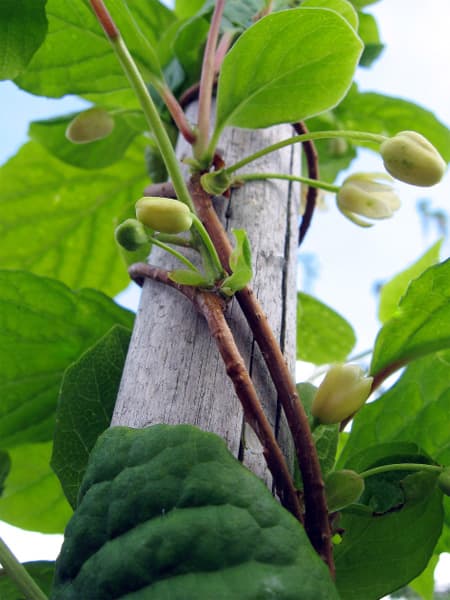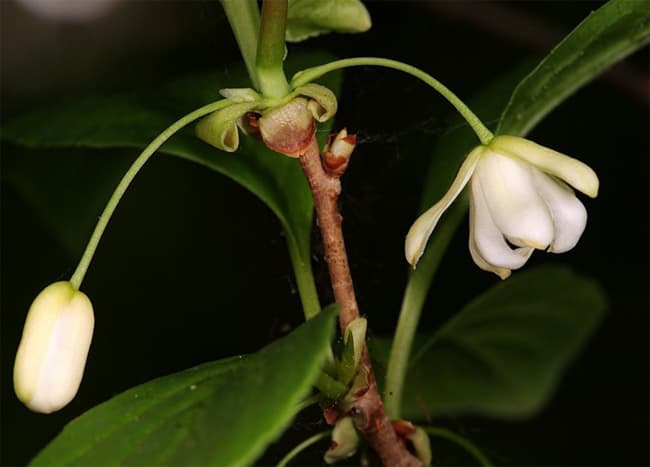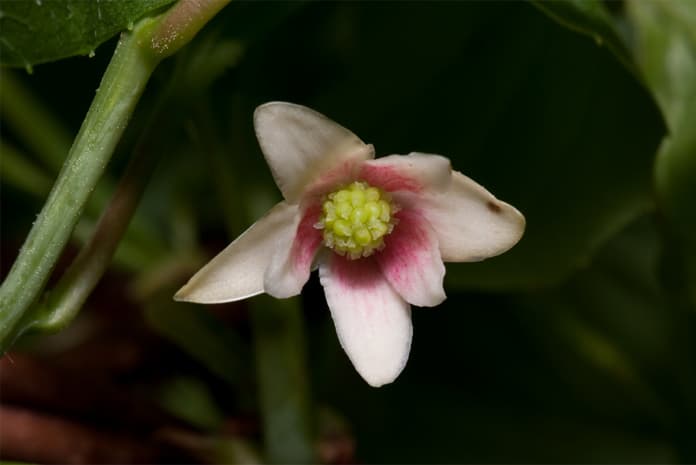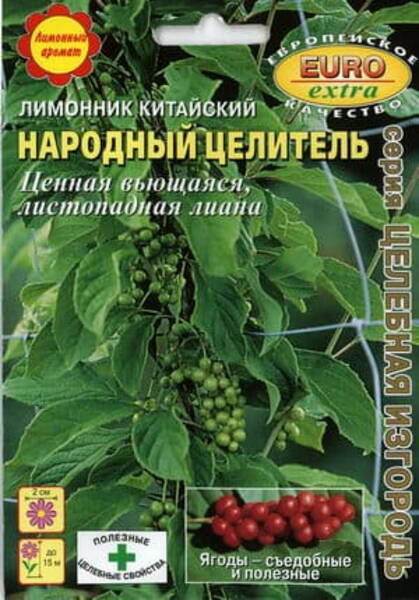Your shopping cart is empty!
Chinese Magnolia Vine ''Wu-wei-zi" (Magnolia berry)
Chinese Magnolia Vine ''Wu-wei-zi" - Schisandra chinensis.
Location: fairly shade-tolerant, especially when young. Frost-resistant.
Soil: Prefers light, humus-rich, moist and well-drained soil.
Landing: it is better to plant several plants at the age of two to three years in a trench 50 cm wide and no more than 60 cm deep. In the middle of it, at a distance of 1.5 m from each other, metal stakes are driven in to secure the support. Drainage is placed at the bottom of the trench: crushed stone, gravel, broken brick, construction debris with a layer of 30 cm and slightly compacted.
You can plant plants in two rows with a row spacing of 60-70 cm with a row spacing of 1 m. When planting, the strongest seedling shoot is cut into three buds, the roots are shortened by 20-25 cm, weak shoots are removed. The roots are dipped in a clay mash with mullein (1 liter per bucket). The seedling is placed on a cone-shaped tubercle, the roots are spread in all directions and sprinkled with soil, then it is compacted. From above, the roots are covered with fertile soil mixed with manure (8-10 kg per 1 m2), sand (three to four buckets), then 500 g of lime, 150 g of phosphorus, 40-50 g of nitrogen are added for each 1 m2. Planting time is spring or autumn. Instead of superphosphate, phosphate flour can be added. Lemongrass reacts very well to wood ash, grows better and bears fruit.
Care: mineral fertilizers should be applied annually: 30 g of superphosphate, 10 g of potassium chloride, 3 g of potassium sulfate, 20 g of wood ash, 20 g of ammonium nitrate are given per 1 m2. Fertilizers are scattered superficially in the form of mulch, the soil is loosened shallowly, since the roots are at a depth of 8-10 cm. Pruning is carried out in winter and late autumn. The diameter of the crown should not exceed 1 m.
Sometimes lemongrass is attacked by lemon gall midge, which destroys flower buds. Leaves and seeds damage bed bugs. Young seedlings are sometimes threatened by Fusarium wilt. Abundant autumn watering and mulching with peat or dry leaves save the roots from severe freezing.
Reproduction: renewed by seeds and root shoots. It tolerates transplant well. Propagated well by seeds, layering and dividing the bush. Woody winter cuttings from shoots cut in winter do not root. Summer green cuttings are also difficult to root - 19-20% rooting is considered a good result. In addition, they do not overwinter in greenhouses, they freeze out, so in the fall they need to be dug up and kept in the basement, and planted again in the spring.
Vegetatively propagated lemongrass will be the same sex as the parents. Therefore, those who simply dig up plants in the taiga and then transfer them to the garden make a big mistake. Firstly, in the taiga you can collect creepers of an unknown gender, since there are purely male or purely female forms, and they usually grow in clumps. Then in the garden of male vines, after flowering, flowers will fall off and women will not start fruiting. Therefore, plants are needed only with a known sex or monoecious, which have both female and male flowers on the same vine. In addition, lemongrass plants transferred from the taiga to the garden will bring specific diseases with them ...
All these misunderstandings can be avoided if you grow lemongrass from seeds. Observations have shown that monoecious plants grow from seeds. They will ensure timely pollination of female flowers by male ones and fruits will appear.


Location: fairly shade-tolerant, especially when young. Frost-resistant.
Soil: Prefers light, humus-rich, moist and well-drained soil.
Landing: it is better to plant several plants at the age of two to three years in a trench 50 cm wide and no more than 60 cm deep. In the middle of it, at a distance of 1.5 m from each other, metal stakes are driven in to secure the support. Drainage is placed at the bottom of the trench: crushed stone, gravel, broken brick, construction debris with a layer of 30 cm and slightly compacted.
You can plant plants in two rows with a row spacing of 60-70 cm with a row spacing of 1 m. When planting, the strongest seedling shoot is cut into three buds, the roots are shortened by 20-25 cm, weak shoots are removed. The roots are dipped in a clay mash with mullein (1 liter per bucket). The seedling is placed on a cone-shaped tubercle, the roots are spread in all directions and sprinkled with soil, then it is compacted. From above, the roots are covered with fertile soil mixed with manure (8-10 kg per 1 m2), sand (three to four buckets), then 500 g of lime, 150 g of phosphorus, 40-50 g of nitrogen are added for each 1 m2. Planting time is spring or autumn. Instead of superphosphate, phosphate flour can be added. Lemongrass reacts very well to wood ash, grows better and bears fruit.
Care: mineral fertilizers should be applied annually: 30 g of superphosphate, 10 g of potassium chloride, 3 g of potassium sulfate, 20 g of wood ash, 20 g of ammonium nitrate are given per 1 m2. Fertilizers are scattered superficially in the form of mulch, the soil is loosened shallowly, since the roots are at a depth of 8-10 cm. Pruning is carried out in winter and late autumn. The diameter of the crown should not exceed 1 m.
Sometimes lemongrass is attacked by lemon gall midge, which destroys flower buds. Leaves and seeds damage bed bugs. Young seedlings are sometimes threatened by Fusarium wilt. Abundant autumn watering and mulching with peat or dry leaves save the roots from severe freezing.
Reproduction: renewed by seeds and root shoots. It tolerates transplant well. Propagated well by seeds, layering and dividing the bush. Woody winter cuttings from shoots cut in winter do not root. Summer green cuttings are also difficult to root - 19-20% rooting is considered a good result. In addition, they do not overwinter in greenhouses, they freeze out, so in the fall they need to be dug up and kept in the basement, and planted again in the spring.
Vegetatively propagated lemongrass will be the same sex as the parents. Therefore, those who simply dig up plants in the taiga and then transfer them to the garden make a big mistake. Firstly, in the taiga you can collect creepers of an unknown gender, since there are purely male or purely female forms, and they usually grow in clumps. Then in the garden of male vines, after flowering, flowers will fall off and women will not start fruiting. Therefore, plants are needed only with a known sex or monoecious, which have both female and male flowers on the same vine. In addition, lemongrass plants transferred from the taiga to the garden will bring specific diseases with them ...
All these misunderstandings can be avoided if you grow lemongrass from seeds. Observations have shown that monoecious plants grow from seeds. They will ensure timely pollination of female flowers by male ones and fruits will appear.




Chinese Magnolia Vine, Wu-wei-zi, "Five Flavor Berry", Magnolia Berry. Bot.syn.: Schizandra chinensis.












